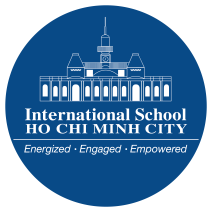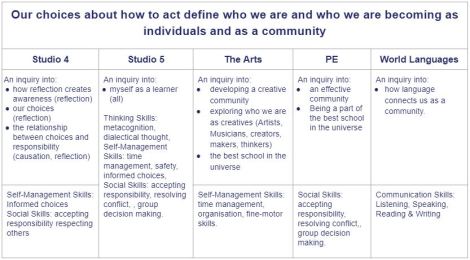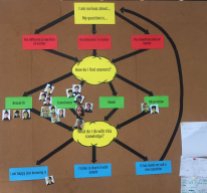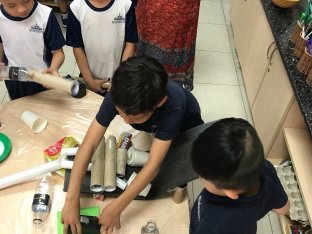Shu – Ha – Ri
Wikipedia (https://en.wikipedia.org/wiki/Shuhari) gives the translation as: “to keep, to fall, to break away”. The name comes from Japanese martial arts (particularly Aikido), and is a way of thinking about how you learn something and the idea that a person passes through three stages of gaining knowledge:
- Shu (守), “protect”, “follow the rule”: in this phase the practitioner apply every method, approach or rule that the teacher provides. The rule is followed to the letter. This is where it’s important to follow every detail, even if it seems unimportant, and not deviate from the teachings. The rules are also repeated over and over in order to assimilate them. This is important not because a specific path is better than the other, but because following a single path till the end is the most efficient way to learn.
- Ha (破), “cut”, “break the rule”: the practitioner has now reached a level where all the rules are well known and it’s possible to break them when necessary. The practitioner is also able to teach other learners, discuss the topic and improve the discipline itself. This is when the rules are questioned, the reason of their existence is put into the spotlight and the foundation becomes visible from the high point of the Shu studies.
- Ri (離), “depart”, “be the rule”: the practitioner now doesn’t just follow the rule, methods and approaches: the practitioner is the rule, transcends the rule. The concepts are so well assimilated that are second nature, and they can be even completely abandoned if the goal requires it. The practitioner is extending the discipline.
As a PYP school, we have the IB Standards and Practices to guide us as we develop our written, taught and assessed curriculum. I say ‘guide’, because I do believe that is what they do – they ‘guide’ they do not ‘tell’.
Applying the idea of Shu-Ha-Ri to our understanding of the PYP, there are those us who are just beginning their PYP journey and in the Shu (守) stage of their learning . They want to know ‘how’ its done, what it ‘looks’ like and ‘what’ to do. We’ve all been there and we’ve had to go through that time of learning, of struggle and trying to unpack the documents, the jargon and what it looks like in action.
As we’ve become a little more comfortable and had a little more experience with the PYP, we move in to the Ha (破) stage. Those with a little more confidence, who’ve had time to not only unpack the documents but also to begin to question and discuss their content and had time to ‘live’ it, time to plan, guide and reflect on units of inquiry and develop a better understanding of the PYP. We are ready to ‘play’, to ‘test the deeper waters’.
Then there are those of us in the Ri (離) stage. Those who have had time and experience, had some successes and failures, learnt through mistakes and challenges and had time and opportunity to learn with and from others, look deeper into the documents and look past assumptions and actually pull out the intent of the words and then….. make them our own.
When it comes to understanding of the PYP, we all have both teachers and administrators in each of the stages of Shu (守) Ha (破) Ri (離) and there are those that may never move from the first two stages, and that’s ok.

The International School of Ho Chi Minh City (ISHCMC) is renown for its innovative approaches, and this is mainly due to a leadership and a culture that believes in disrupting the norms, being creative, seeing things in a different way and first and foremost having our students learning as the priority in this fast changing world.
Our Mission Statement has the three words “Energized, Engaged, Empowered” embedded into it and this permeates our culture of learning at ISHCMC.
We embrace and welcome those practitioners ready to move into the Ri (離) stage – competent practitioners who are confident enough to question and challenge the status quo, innovate and are wanting to take some bold steps forward.
For the last couple of years, our leadership and our teaching teams have stepped boldy in Ri (離) when considering our Programme of Inquiry and our Units of Inqiury and this has continued this year, as we have truly stepped in the Ri (離) and have thought outside of the box when designing units of inquiry.
At the forefront of our purpose has always been to consider our learners – what works best for them, what are their needs, what is authentic, relevant and will allow our learners the time to develop their understanding, their skills and give them the opportunity to grow, to share their learning and to have the chance for this learning to lead to student action.
Who We Are – Whole School Unit – Year Long Unit
Two years ago, leadership saw a need to address the culture of our school, who we were as individuals and as parts of the learning community and our codes of behaviour within the school. The team sat down and proposed a whole school unit of inquiry under Who We Are that would permeate through everything we did in the school and as part of the community and would give us a chance to reflect on ourselves, our community and define Who We Are.
The Central Idea for our Who We Are unit is “Our choices about how to act define who we are and who we are becoming, as individuals and as a community.” The unit runs through out the year, is focused on in the first 5 – 6 weeks of the year in all grade levels (EE2 – Studio 5) and is the continued focus in our assemblies. To read more about our whole school unit for Who We Are you can read a little background here.
How the World Works – Early Explorers
At ISHCMC, we have our youngest learners – our Early Explorers; EE2 – 2 Years old. EE3 – 3 years old and EE 4 – 4 years old.
To promote and support collaboration, we are, this year, planning together across the three age groups. Just before our planning session for How the World Works, we had been following with interest the announcements to the ‘Enhanced PYP’ and the focus on play, and has just returned from a Reggio-Emilia weekend PD wih Fiona Zim.
As a team, we were committed to ‘PLAY’ as the essence of the unit and developing an enduring understanding that learning happens through play. The unit was under How the World Works, and this was to be honoured, but whilst EE2 & EE3 thought it developmentally appropriate to focus on construction, EE4 thought their learners were ready to be scientists.
This led to us designing a shared Central Idea, Lines of Inquiry and Key Concepts, but the two units have different lens that they are focusing on through the tuning in stage and are guided by appropriate teacher questions.
As an EE team we developed the Central Idea: “Play encourages exploration and discovery” and the Lines of Inquiry are:
- An inquiry into play (Form)
- An inquiry into what we learn through exploration (Causation)
- An inquiry into the connections between play and learning (Connection)
One unit, one transdisciplinary theme, three age groups, one Central idea and set of Lines of Inquiry being explored through 2 different lenses, construction and science.
How the World Works & How we Express Ourselves – Kindergarten
Our Kindergarten team have planned their unit of inquiry that has two transdisciplinary themes running at the same time with one central idea and lines of inquiry for 12 weeks. The goal was to provide our Kindergarten students the time to play, explore, discover and create and provide opportunities for our young learners to explore elements of both How the World Works and How we Express Ourselves.
The Central Idea the team designed is: “Interacting with light can inspire creative expression “
The Lines of Inquiry:
- An inquiry into light
- An inquiry into what creates light and where we find it
- An inquiry into how we use light for creative expression
- An inquiry into how light sparks emotion and feeling.
Where we are in Place and Time – Grade 3.
When the Grade 3 team sat down to plan their unit on Where we are in Place and Time, we were very aware that our essence was ‘exploration‘ – what followed was a number of discussions as to the type of exploration that the unit could lend it self and we struggled a as we wanted to be able to leave the unit open so the students could have choice, freedom and opportunity to inquire and ‘explore’ both in depth and breadth.
During planning and formulation of the Central Idea – we as adults couldn’t come to a consensus on the wording and were concerned that if we did choose certain words we would close off opportunities for our learners.
We decided we didn’t want to ‘tell’ the learners what to think and thus, in a moment of Ri (離) ageed on presenting to our learners an incomplete Central Idea.
Does this ‘break’ a couple of the rules and guidelines set by the IB for a Central Idea? Absolutely, but we think we’ve been able to bend these through the final task for our Grade 3 learners. The final task of the unit for our learners for them to complete the Central Idea themselves and be able to present, debate and justify their choice of words and have the supporting evidence through their research and own explorations.
The Central Idea: “Exploring the unknown leads to…..” .
Lines of Inquiry:
- An inquiry into what it means to explore. (Form)
- An inquiry into an explorer’s journey (Form, Causation)
- An inquiry into the effect of exploration (Causation)
How we Organise Ourselves & Sharing the Planet – Grade 4
The Grade 4 team’s How we Organise Ourselves unit was to focus on economics and trade. Through discussions around the essence of the unit, the Grade 4 team agreed that the enduring understanding should be responsibility as consumers and an understanding of the impact of consumerism.
As we unpacked the unit, read previous unit reflections, it became clear that 6 weeks would not be enough time in a busy school to unpack this with the learners in a meaningful way that could lead to student action.
We noted that the following unit was scheduled to be Sharing the Planet. We wondered, if we could possibly unpack the knowledge, concepts and big ideas for the 6 weeks of How we Organise Ourselves – and then use the time dedicated to Sharing the Planet to apply this knowledge, develop skills and then lead to learner action?
The creative thinking and our inner Ri (離) kicked into action. We began to brainstorm and draft Central Ideas that would fit under both Transdisciplinary Themes with the overarching concept of responsibility.
The Central Idea the team designed is: “Economic activities impact societies”
For How we Organise Ourselves, our lines of inquiry are:
- An inquiry into economic activities. (Function)
- An inquiry into the factors that determine price. (Causation)
- An inquiry into the roles and responsibilities of the producers, traders and consumers. (Responsibility)
And then, once our Grade 4 learners had a grasp on trade, economic activies and the different roles involved in economics and trade; we rolled naturally into the Lines of Inuiry for Sharing the Planet:
- An inquiry into finite resources. (Causation)
- An inquiry into the relationship between resources, people, and the planet (Function, Causation)
- An inquiry into action towards sustainability (Responsibility)
The units ran back to back over 13 weeks and led to Students making ‘pitches’ for sustainable action and developing an authentic sense of responsibility as consumers. We continue to be amazed by their dedication to action.
Four Units – One Central Idea – Self-Directed – Studio 5
 Our Studio 5 model seeks to disrupt the norms of traditional enducation and totally commit to celebrating and embracing self-directed learning and student agency.
Our Studio 5 model seeks to disrupt the norms of traditional enducation and totally commit to celebrating and embracing self-directed learning and student agency.
Through our learning journey – we began the year by looking at each unit of inquiry in isolation and started with our whole school unit of Who We Are as we established routines and explored who we were as a Studio community and as individual learners.
We then headed into How the World Works…. but we struggled, and so did the students. Although the team had planned for room for deep inquiry, we felt that it was still the teachers’ planning and for a model that was trying to push and celebrate agency this felt uncomfortable – for all involved.
So we went back to planning, and wondering and asking “what if?” The Studio 5 team came to planning with an idea and some questions:
- “Could we have one Central Idea that would span the remaining 4 units of inquiry?”
- “Did all learners have to be on the same Transdisciplinary theme at the same time?”
- “Did they have to be on only ONE Transdisciplinary theme at a time?”
- “Did each student’s unit have to be of the same length of time?”
- “Could we not approach the rest of the year, and the remaining units as we did the PYPx – allowing students to plan their units, make connections and drive their learning?”
These led to more questions and wonderings – and not all of them have been addressed (yet!) but we embraced our Ri (離) and went for it.
The over-arching Central Idea for Studio 5: ” Success hinges on motivation”
The Lines of Inquiry:
- An inquiry into what is means to be successful
- An inquiry into the pathway / process to success
- An inquiry into reasons that we persevere or pivot
With students choosing their own learning , identifying which of the Transdisciplinary Themes they’ve connected with and which of the concepts, ATL skills and attributes of the Learner Profile they’ve explored and developed.
You can follow our #Studio5 journey on Twitter, through the personal blog of one of our practitioers Taryn Bond Clegg (https://makinggoodhumans.wordpress.com/ ) or by visiting our Studio 5 website (http://studio5.ishcmc.edu.vn/).
Reflection –
It is important to remember that there is no perfect Programme of Inquiry, but, at ISHCMC we are committed to learning, to creative thinking, to reflecting and to taking bold steps and continuing to embrace the philosophy of Shu (守), Ha (破), Ri (離) because that’s who we are and we believe “Our choices about how to act define who we are and who we are becoming, as individuals and as a community.”
 For those a little sceptical and nervous about the ‘IB’ visitors or the IB Standards not being adhered to – I say; ‘read the documents, unpack their essence, understand the language and the intent then play a little with Ha (破) and take that first step – because afterall, no one is going to bleed or get hurt and if conversations are about the learners and the learning …. then really, what can go wrong?
For those a little sceptical and nervous about the ‘IB’ visitors or the IB Standards not being adhered to – I say; ‘read the documents, unpack their essence, understand the language and the intent then play a little with Ha (破) and take that first step – because afterall, no one is going to bleed or get hurt and if conversations are about the learners and the learning …. then really, what can go wrong?
Then, when you and your team are ready – embrace the Ri (離) – ’cause its a little bit magical when it happens!
ISHCMC Programme of Inquiry 2017 – 2018 – HERE to view.






 A few meetings later, our Head of School (
A few meetings later, our Head of School ( If our gut did believe that this model was successful – and we had all this ‘noise’ – could we, as a school, a group of determined educators who were committed to change, could we come up with “an authentic system that shows growth of our learners in a self-directed model.”
If our gut did believe that this model was successful – and we had all this ‘noise’ – could we, as a school, a group of determined educators who were committed to change, could we come up with “an authentic system that shows growth of our learners in a self-directed model.”  We eventually came back to our PYP ATL skills. Sometimes time and space to explore and gain perspective leads us to appreciate what we had in front of us the whole time.
We eventually came back to our PYP ATL skills. Sometimes time and space to explore and gain perspective leads us to appreciate what we had in front of us the whole time.













 This year there has been a spotlight on
This year there has been a spotlight on 















 Our Studio 5 model seeks to disrupt the norms of traditional enducation and totally commit to celebrating and embracing self-directed learning and student agency.
Our Studio 5 model seeks to disrupt the norms of traditional enducation and totally commit to celebrating and embracing self-directed learning and student agency. For those a little sceptical and nervous about the ‘IB’ visitors or the IB Standards not being adhered to – I say; ‘read the documents, unpack their essence, understand the language and the intent then play a little with Ha (破) and take that first step – because afterall, no one is going to bleed or get hurt and if conversations are about the learners and the learning …. then really, what can go wrong?
For those a little sceptical and nervous about the ‘IB’ visitors or the IB Standards not being adhered to – I say; ‘read the documents, unpack their essence, understand the language and the intent then play a little with Ha (破) and take that first step – because afterall, no one is going to bleed or get hurt and if conversations are about the learners and the learning …. then really, what can go wrong?